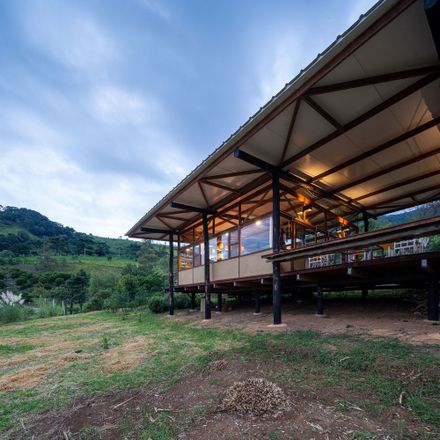Acaiacá House
WOOD STOVE
Paulo Custódio
WOODWORK
Renato Barros
PROJECT TEAM
Camila Ungaro, Manoela Pessoa, Victória Menezes, Thiago Benucci
MANUFACTURERS
Autodesk, Dupont, Ciasul, Perfilor, Siva, Trimble
STRUCTURAL CONSULTANTS
Heloísa Maringoni
Text description provided by architect.
At 1200 meters of altitude, in the Mantiqueira Mountains (Serra da Mantiqueira), a mountain range in Southeastern Brazil, the project proposes a conscious use of the local resources of the land and surroundings, to promote an experimental construction, sensitive to local knowledge and with a low impact on the environment.
From this premise, the construction is basically made of wood and earth. Industrialized materials, in turn, were thought of to rationalize the work, ensuring the minimization of waste, adapting to the context of difficult access to the land and local climatic conditions.
The roof's structural system consists of thermal insulating metal tile panels, supported by six frames in eucalyptus trunks separated by spans of 4 meters between them.
The internal structure, designed to accommodate the floors and closures, is independent of the roof structure and has spans of 3 meters between the supports. The main structure was developed with the round trunks of 12 eucalyptus trees, taken from a nearby forest.
From the survey of the chosen trees, a cutting scheme was carried out to make better use of the trunks.
The parts were then cut with a chainsaw and treated by a carbonization process with a homemade blowtorch at the assembly site.
The assembly took place as an artisanal process, by a team of four people, without any special equipment.
After locating the pillars, the floor structure was built, using it as the base and support of a single metallic scaffold that was moved for the manual assembly of the six beams of the frames.
These beams consist of logs measuring approximately 20 centimeters in diameter and were reinforced with a steel cable tie, forming a wagon beam with a total length of 12 meters to cover a central span of 8 meters.
The layout of the house is divided into two boxes of practically the same size, under this roof. These two independent volumes, in sawn wood and with wattle and daub (pau-a-pique) closures and glass, have a structure independent of the roof, providing a sense of lightness to the whole set.
The internal framework of the wattle and daub (pau-a-pique) was made with bamboo from the site, and the earth removed from the specific excavations necessary for the work was used for the constructions using earth.
The more opaque volume, intended for reserved and nocturnal use, houses two bedrooms and two equal bathrooms; the more transparent box, intended for social and daytime interaction, houses a living room/kitchen, with a wood stove in the center of the space.
The gap between the two volumes houses an area on a wooden deck, covered and open to the view, which is configured both as access, like a balcony, and a living space.




























